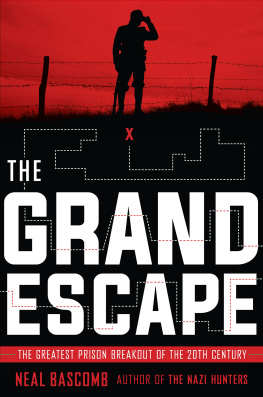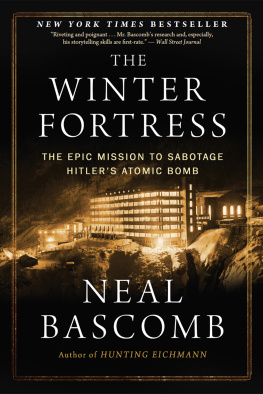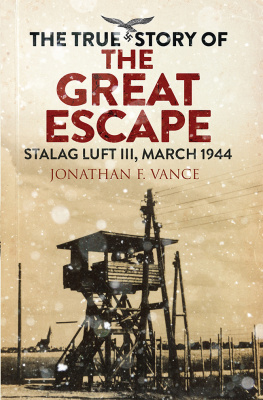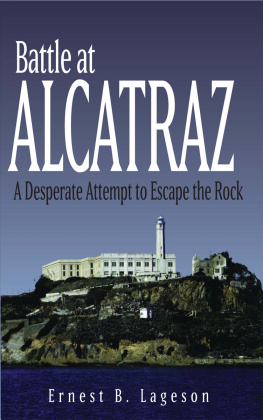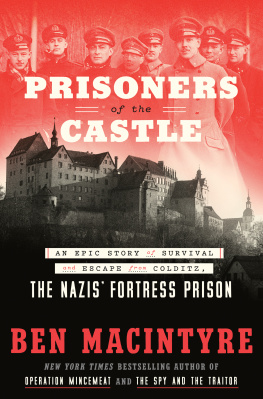
Contents
Text copyright 2018 by Neal Bascomb
All rights reserved. Published by Arthur A. Levine Books, an imprint of Scholastic Inc., Publishers since 1920 , in association with Scholastic Focus. SCHOLASTIC , the LANTERN LOGO , and the SCHOLASTIC FOCUS LOGO are trademarks and/or registered trademarks of Scholastic Inc.
The publisher does not have any control over and does not assume any responsibility for author or third-party websites or their content.
Library of Congress Cataloging-in-Publication Data
Names: Bascomb, Neal, author.
Title: The grand escape : the greatest prison breakout of the 20th century / by Neal Bascomb.
Other titles: Greatest prison breakout of the 20th century
Description: First edition. | New York : Arthur A. Levine Books, [2018] | Includes bibliographical references and index. | Audience: Grades 9-12. | Audience: Ages 12-18.
Identifiers: LCCN 2018016857| ISBN 9781338140347 (hardcover : alk. paper) | ISBN 1338140345 (hardcover : alk. paper) | ISBN 9781338140354 (ebook) | ISBN 1338140353 (ebook)
Subjects: LCSH: World War, 1914-1918Prisoners and prisons, GermanJuvenile literature. | Prisoner-of-war escapesGermanyHolzmindenJuvenile literature. | Prisoners of warGermanyHolzmindenBiographyJuvenile literature. | Prisoners of warGreat BritainBiographyJuvenile literature.
Classification: LCC D627.G3 B29 2018 | DDC 940.4/72430943597dc23 LC record available at https://lccn.loc.gov/2018016857
First edition, October 2018
Cover design by Maeve Norton / Author photo by Jillian McAlley
Cover photos Shutterstock: soldier (Kozlik), fence (lafoto)
e-ISBN 978-1-338-14035-4
All rights reserved under International and Pan-American Copyright Conventions. No part of this publication may be reproduced, transmitted, downloaded, decompiled, reverse engineered, or stored in or introduced into any information storage and retrieval system, in any form or by any means, whether electronic or mechanical, now known or hereafter invented, without the express written permission of the publisher. For information regarding permission, write to Scholastic Inc., Attention: Permissions Department, 557 Broadway, New York, NY 10012.
To Liz, these pages would not sing without you.

BREAKOUT ARTISTS:
Cecil Blain , Royal Flying Corps (RFC) pilot
David Munshi Gray , RFC captain
Caspar Kennard , RFC lieutenant
William Shorty Colquhoun , Canadian lieutenant
Charles Rathborne , senior British officer at Holzminden after Wyndham
Dick Cash , private in the Australian Imperial Force
William Baxter Ellis , RFC pilot
Joseph Rogers , infantry captain, member of the Pink Toes
Frank Moysey , infantry captain, member of the Pink Toes
Harold Medlicott , Royal Air Force (RAF) lieutenant
Captain Joseph Walter , 7/Royal West Surrey Regiment
Peter Lyon , Australian infantry officer
Captain William Leefe Robinson , RFC pilot
Captain Hugh Durnford , Royal Field Artillery officer
Jim Bennett , RNAS observer
Peter Campbell-Martin , RNAS pilot
Walter Basil Butler , infantry lieutenant
Livewire, unnamed ringleader of the Block A escape plot
Jack Morrogh , Royal Irish Regiment major
Lieutenant Edgar Garland , pilot from New Zealand
OTHER ALLIES:
Captain Allouche , French pilot
Major John Wyndham , senior British officer at Holzminden
Lord Newton , head of the British Prisoner of War Department
GERMANS AT HOLZMINDEN:
Captain Karl Niemeyer , commandant of Holzminden after Habrecht
General von Hnisch , head of the 10th Army Corp Division, including Holzminden
Colonel Habrecht , commandant of Holzminden
Kurt Grau , camp interpreter
Mandelbrat , lieutenant to Niemeyer
OTHER GERMANS:
Kaiser Wilhelm II , German Emperor and King of Prussia
Oswald Belcke , German ace
Baron Manfred von Richthofen , German ace, aka the Red Baron
Commandant Blankenstein , commandant of Osnabrck
Commandant Courth , commandant of Crefeld
Commandant Wolfe , commandant of Clausthal
Commandant Krner , commandant of Bad Colberg

Dr. Rudolf Rmer , Dutch attach assigned to inspect German POW camps for compliance with the Hague Convention
Stone walls do not a prison make, / nor iron bars a cage.
To Althea, from Prison
Richard Lovelace, inscribed on a Holzminden cell wall
It seems to me that we owed it to our self-respect and to our position as British officers to attempt to escape, and to go on attempting to escape, in spite of all the hardships.
A. J. Evans


Trench warfare in World War I.


H OLZMINDEN, 1918.
Twenty-seven-year-old Lieutenant Caspar Kennard was the number-one man, the digger, this afternoon. He wriggled through the eighteen-inch-diameter tunnel, a hundred feet from its entrance. In one hand he held a flickering candle, its light casting a devilish dance of shadows about him. With the other hand, he clawed at the dirt to drag himself forward. Roped to his leg was a shallow bin to bring out the excavated earth. Finally, after almost thirty minutes of crawling, he reached the end of the burrow. He scooped out a shelf in the mud wall, set down the candle, and briefly watched the flame struggle to survive in the oxygen-starved air. He took a breath, calmed himself best as he could, then started digging into the firm mix of stone and yellow clay.
Far behind him, at the mouth of the tunnel underneath a narrow paneled staircase, David Gray, the number-two man, muscled the bellows and pumped air down to Kennard. Behind Gray, the number-three man, Cecil Blain, waited to haul out the bin and pack the earth into the steadily shrinking space under the stairs. Each shift they rotated the jobs. Nobody liked to be the digger.
Tunneling was a nasty business. Kennard barely had space to shift his body. The burrow reeked of stale air, mildew, sweat, and rot. There were rats, worms, and other creepy-crawlies, and never enough air to breathe. He was always banging his head against stones, and earth pressed on him in every direction, threatening to collapse and snuff out his life. Given his lifelong fear of confined spaces, Kennard had to force himself not to panic.
Inch by inch, he carved out a small stretch of tunnel, then he contorted his body to fill the bin with dirt and rocks. There was months more of this mole work ahead, months more of digging what was either a very long tomb or a path to freedom from Holzminden, the notorious German prison camp in which they were all incarcerated. Once beyond the walls of this landlocked Alcatrazif they made it that farhe and his fellow prisoners would have to make a 150-mile journey by foot through enemy territory to the border. The Germans would assuredly launch a manhunt, and they could face recaptureor a bulletat any turn.
Next page
